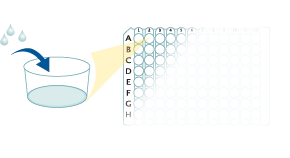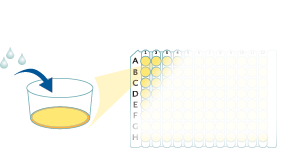Glucagon Quantikine ELISA Kit Summary
Product Summary
Recovery
The recovery of Glucagon spiked to levels throughout the range of the assay in various matrices was evaluated.
| Sample Type | Average % Recovery | Range % |
|---|---|---|
| Cell Culture Media (n=4) | 98 | 91-108 |
| Human EDTA Plasma (n=4) | 98 | 86-107 |
| Human Heparin Plasma (n=4) | 96 | 88-100 |
| Human Serum (n=4) | 102 | 95-111 |
| Mouse Serum (n=2) | 99 | 92-106 |
| Porcine Serum (n=2) | 97 | 91-107 |
| Rat Serum (n=1) | 93 | 86-101 |
Linearity
Scientific Data
Product Datasheets
Preparation and Storage
Background: Glucagon
Glucagon is a 29 amino acid (aa) peptide produced by the pancreas that plays a critical role in glucose metabolism and homeostasis (1-4). The Glucagon precursor mRNA is expressed by alpha cells ( alpha -cells) of the pancreas, L cells of the intestine, and in the brain (1, 2). Only the pancreatic alpha -cells express the prohormone convertase PC2, also called PCSK2, which is required to produce Glucagon (2). Intestinal L cells instead express the prohormone convertase PC1, which processes the precursor to the Glucagon-overlapping peptides glicentin and oxyntomodulin. L cells also produce two Glucagon-like peptides, GLP-1 and GLP-2 that are derived from the same Glucagon precursor and influence glucose metabolism, but do not share any common sequence with Glucagon (1, 2). The aa sequence of the mature Glucagon peptide is identical in human, mouse, rat, pig, dog, horse, cow, sheep, and Xenopus.
Assay Procedure
Refer to the product- Prepare all reagents, standard dilutions, and samples as directed in the product insert.
- Remove excess microplate strips from the plate frame, return them to the foil pouch containing the desiccant pack, and reseal.
- Wash and aspirate the plate a total of 2 times with Wash Buffer prior to assay.
- Add 150 µL of Assay Diluent to each well.
- Add 50 µL of Standard, control, or sample to each well. Cover with a plate sealer, and incubate at room temperature for 3 hours.
- Aspirate each well and wash, repeating the process 3 times for a total of 4 washes.
- Add 200 µL of cold Conjugate to each well. Cover with a new plate sealer, and incubate at 2-8 °C for 1 hour.
- Aspirate and wash 4 times.
- Add 200 µL Substrate Solution to each well. Incubate at room temperature for 30 minutes. PROTECT FROM LIGHT.
- Add 50 µL of Stop Solution to each well. Read at 450 nm within 30 minutes. Set wavelength correction to 540 nm or 570 nm.





Citations for Glucagon Quantikine ELISA Kit
R&D Systems personnel manually curate a database that contains references using R&D Systems products. The data collected includes not only links to publications in PubMed, but also provides information about sample types, species, and experimental conditions.
16
Citations: Showing 1 - 10
Filter your results:
Filter by:
-
Kaempferol ameliorates metabolic syndrome by inhibiting inflammation and oxidative stress in high-fat diet-induced obese mice
Authors: Shin, SK;Kwon, EY;
Nutrition research and practice
Species: Mouse
Sample Types: Plasma
-
Gut AstA mediates sleep deprivation-induced energy wasting in Drosophila
Authors: Li, Y;Zhou, X;Cheng, C;Ding, G;Zhao, P;Tan, K;Chen, L;Perrimon, N;Veenstra, JA;Zhang, L;Song, W;
Cell discovery
Species: Mouse
Sample Types: Cell Culture Supernates, Serum
-
Low glycaemic diets alter lipid metabolism to influence tumour growth
Authors: EC Lien, AM Westermark, Y Zhang, C Yuan, Z Li, AN Lau, KM Sapp, BM Wolpin, MG Vander Hei
Nature, 2021-10-20;0(0):.
Species: Human
Sample Types: Plasma
-
Intervention of Gastrodin in Type 2 Diabetes Mellitus and Its Mechanism
Authors: Y Bai, K Mo, G Wang, W Chen, W Zhang, Y Guo, Z Sun
Frontiers in Pharmacology, 2021-09-16;12(0):710722.
Species: Rat
Sample Types: Serum
-
Glucagon receptor antagonism promotes the production of gut proglucagon-derived peptides in diabetic mice
Authors: S Lang, R Wei, T Wei, L Gu, J Feng, H Yan, J Yang, T Hong
Peptides, 2020-06-16;131(0):170349.
Species: Mouse
Sample Types: Plasma
-
Low-Energy Extracorporeal Shock Wave Ameliorates Streptozotocin Induced Diabetes and Promotes Pancreatic Beta Cells Regeneration in a Rat Model
Authors: CC Hsiao, CC Lin, YS Hou, JY Ko, CJ Wang
Int J Mol Sci, 2019-10-05;20(19):.
Species: Rat
Sample Types: Tissue Lysates
-
Sodium butyrate reduces high-fat diet-induced non-alcoholic steatohepatitis through upregulation of hepatic GLP-1R expression
Authors: D Zhou, YW Chen, ZH Zhao, RX Yang, FZ Xin, XL Liu, Q Pan, H Zhou, JG Fan
Exp. Mol. Med., 2018-12-03;50(12):157.
Species: Human
Sample Types: Serum
-
Alpha cell function interacts with diet to modulate prediabetes and Type 2 diabetes
Authors: I Roncero-Ra, R Jimenez-Lu, JF Alcala-Dia, C Vals-Delga, AP Arenas-Lar, OA Rangel-Zuñ, A Leon-Acuña, MM Malagon, J Delgado-Li, P Perez-Mart, JM Ordovas, A Camargo, J Lopez-Mira
J. Nutr. Biochem., 2018-09-01;62(0):247-256.
Species: Human
Sample Types: Plasma
-
Metabolic regulation of GLP-1 and PC1/3 in pancreatic ?-cell line
Authors: V Sancho, G Daniele, D Lucchesi, R Lupi, A Ciccarone, G Penno, C Bianchi, A Dardano, R Miccoli, S Del Prato
PLoS ONE, 2017-11-09;12(11):e0187836.
Species: Mouse
Sample Types: Cell Culture Supernates
-
Involvement of stanniocalcins in the deregulation of glycaemia in obese mice and type 2 diabetic patients
Authors: JJ López, I Jardín, CC Chamorro, ML Duran, MJ Tarancón R, M Reyes Pana, F Jiménez, R Montero, MJ González, M Martínez, MJ Hernández, JM Brull, AJ Corbacho, E Delgado, MP Granados, L Gómez-Gord, JA Rosado, PC Redondo
J. Cell. Mol. Med., 2017-10-09;0(0):.
Species: Mouse
Sample Types: Plasma
-
Hypothalamic Ventromedial Lin28a Enhances Glucose Metabolism in Diet-Induced Obesity
Authors: JD Kim, C Toda, CM Ramírez, C Fernández-, S Diano
Diabetes, 2017-05-26;0(0):.
Species: Mouse
Sample Types: Plasma
-
Effects of Three Commercially Available Sports Drinks on Substrate Metabolism and Subsequent Endurance Performance in a Postprandial State
Authors: L Qin, QR Wang, ZL Fang, T Wang, AQ Yu, YJ Zhou, Y Zheng, MQ Yi
Nutrients, 2017-04-12;9(4):.
Species: Human
Sample Types: Serum
-
Inhibition of the glucose transporter SGLT2 with dapagliflozin in pancreatic alpha cells triggers glucagon secretion.
Authors: Bonner C, Kerr-Conte J, Gmyr V, Queniat G, Moerman E, Thevenet J, Beaucamps C, Delalleau N, Popescu I, Malaisse W, Sener A, Deprez B, Abderrahmani A, Staels B, Pattou F
Nat Med, 2015-04-20;21(5):512-7.
Species: Human, Mouse
Sample Types: Cell Culture Supernates
-
Vitamin A deficiency causes hyperglycemia and loss of pancreatic beta-cell mass.
Authors: Trasino S, Benoit Y, Gudas L
J Biol Chem, 2014-12-01;290(3):1456-73.
Species: Mouse
Sample Types: Serum
-
Hypothalamic prolyl endopeptidase (PREP) regulates pancreatic insulin and glucagon secretion in mice.
Authors: Kim J, Toda C, D'Agostino G, Zeiss C, DiLeone R, Elsworth J, Kibbey R, Chan O, Harvey B, Richie C, Savolainen M, Myohanen T, Jeong J, Diano S
Proc Natl Acad Sci U S A, 2014-07-28;111(32):11876-81.
Species: Mouse
Sample Types: Tissue Homogenates
-
A novel oral dual amylin and calcitonin receptor agonist (KBP-042) exerts antiobesity and antidiabetic effects in rats.
Authors: Andreassen K, Feigh M, Hjuler S, Gydesen S, Henriksen J, Beck-Nielsen H, Christiansen C, Karsdal M, Henriksen K
Am J Physiol Endocrinol Metab, 2014-05-06;307(1):E24-33.
Species: Rat
Sample Types: Plasma
FAQs
No product specific FAQs exist for this product, however you may
View all ELISA FAQsReviews for Glucagon Quantikine ELISA Kit
Average Rating: 5 (Based on 1 Review)
Have you used Glucagon Quantikine ELISA Kit?
Submit a review and receive an Amazon gift card.
$25/€18/£15/$25CAN/¥75 Yuan/¥2500 Yen for a review with an image
$10/€7/£6/$10 CAD/¥70 Yuan/¥1110 Yen for a review without an image
Filter by:
works for mouse serum





